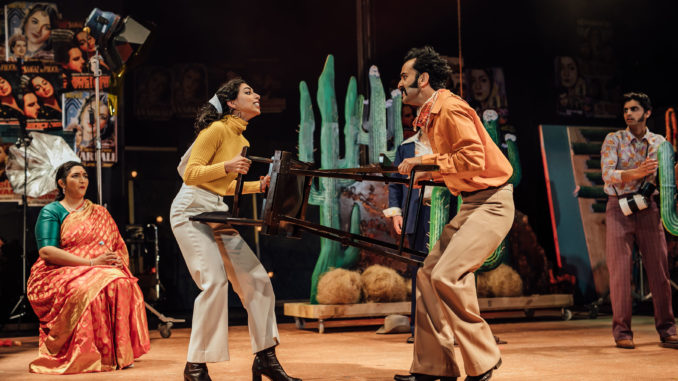
[What could we do with sustainable practice?]
The challenges of making a living out of the performing and screen arts are well known to the industry, but there is something about seeing the facts in black and white that throws the problem into stark relief. I’m talking about research commissioned by Creative New Zealand and NZ on Air released in May this year which found the average wage for creative professionals in Aotearoa is $36,000, below the living wage (42K in 2018). “Most rely on other sources of financial support such as another job or a partner’s income to survive, and most can’t dedicate as much time to their art or creative practice as they would like.”
Drilling further into the data, the average wage for people involved in acting and theatre production was even less at $32,400 per year, and these practitioners recorded the second lowest career satisfaction rating (ahead of music and sound) at 45%, meaning they were “more likely than average to think there are not sufficient opportunities for them to sustain their creative career in New Zealand.” Dance professionals recorded the lowest annual income at $17,500. These income figures compare with the annual median income of New Zealanders earning a wage and salary of $51,800 and the median total income of self-employed people at $37,900.
These findings are amplified by figures from Basement Theatre, the ground spring of independent theatre in Tāmaki Makaurau. In a welcome move of accountability, The Basement released a report card from their 2018 season and the census results from a survey of their artists. While 94% of the shows The Basement hosted were reported to have broken even, the financial figures were sobering:

Compounded with artists investing their own money in shows, that’s an awfully long way off living wage. When The Basement asked the artists who considered the arts to be their main occupation how likely it was that they would cover their basic living expenses solely through their arts, 49% answered “extremely unlikely to not very likely.” The Basement found that 54% of their own community earned less than 40,000 in 2018.
As part of a culture of having little, there is a perception that those starting out shouldn’t expect to make much of an income, if at all, from theatre, and newcomers go along with this, working for experience. But after ‘paying their dues’ they soon find that the next rung is horizontal rather than vertical, and there isn’t really anywhere else to go to get that dependable income. Look again at The Basement’s graphic – we’re talking $3.92 per hour for mid-career artists. The other problem with the ‘work for free while you’re new’ mentality is that it pretty quickly puts barriers in place around who can afford to participate, with artists being forced to put their practice on the back-burner as the cost of living climbs even higher. The fact is that all of us are poorer if artists disappear from the industry, not because they don’t feel like they have anything more to say, but because they don’t feel they can afford to say it. In the arts ecology, we need to be doing all we can to nurture the shoots coming through, especially if we want a healthy scene with a plurality of stories and perspectives.
As part of a discussion with RNZ, Jo Randerson (whose company, Barbarian Productions, become the first performing arts company to gain living wage accreditation) pointed towards the need for more professional development around sustainability:
We go out and teach sometimes around the living wage and I work with artist and I say “What’s your hourly rate?” Some people can quote that immediately. Other people have no idea. If you want to stay like that that’s fine. But I think we need to start talking about money for those who want to. Where is the professional development for us to grow that way of our thinking. I see people come out [of training] and then after two years they’re broke they’re disempowered, the beautiful star career trajectory they had for themselves has not come to fruition. […] They’re very skilled, talented people who’ve invested in an education and they don’t know how to make a sustainable career.
A decade ago the arts in Aotearoa was in a belt-tightening mode following the global financial crisis. As we enter a new decade, the figures from CNZ/NZ on Air and Basement Theatre suggests that the dial has barely moved. Indeed, there are fewer people employed in the creative industries on yearly contracts as the gig economy mentality takes over.
It would be great to see other leaders in Tāmaki Makaurau – Q Theatre, Auckland Live, Auckland Theatre Company – follow Basement Theatre’s lead and release an annual report card on how they are doing on financial and other indicators (gender, ethnicity, access). Having measurable data, rather than relying on anecdote, is an important part of being able to move the dial for the betterment of artists and audiences.
A $1 million increase in Creative New Zealand’s baseline funding, especially targeted to “improve career sustainability” for practitioners is a welcome move, if really only pocket money for the Government (the $1 million increase is in addition to an extra $4.5 million CNZ has earmarked annually for its Tōtara and Kahikatea investment clients, which include many theatre organisations). The change has made a difference in Creative New Zealand’s arts grants rounds: CNZ recommends applicants should be paying their team at least $25 per hour, combined with a new strategic objective that projects should be considering fair remuneration with which assessors can now scrutinize applications (it says a lot about how we value the product more than the artists that this wasn’t already prioritised for funding!). There remains a tension with the difficulty of achieving fair remuneration for any projects that aren’t successful in gaining CNZ funding, and with only a relatively small pool being funded each round.
The current Labour led Government is extremely good at giving encouraging rhetoric. While in Australia the arts ministry is alarmingly being folded into the Department of Infrastructure, Transport, Regional Development and Communications (because the only thing holding back arts touring networks is not having enough roads), Jacinda Ardern has featured on the Australian website Arts Hub outlining a vision for her country “where the creativity and joy that comes from the arts is available to the many, not reserved for a privileged few. I want to see a country where the arts flourish and breathe life into, well, everyday life. I want to see a country where the arts are available to us all and help us express ourselves as unique individuals, brought together in diverse communities.” (During Art Month Jacinda also wrote for The Spinoff that “We can’t say we value our art if we don’t value our artists.”)
However, Professor Peter O’Connor (a leader with Hobson Street Theatre) has pointed out that “despite overwhelming national and international evidence to support the idea that the arts are vital to the wellbeing of individuals, education, communities, and countries,” there has been “no coherent strategy for funding the arts and wellbeing as part of a wider strategy to embed the arts across government policy.”
As we head towards another uncertain election year in 2020, the arts community are left wondering when we will ever see meaningful policy that will match Ardern’s sentiments. If a left-wing Government that rhetorically values the arts can’t deliver, who will? There’s still no movement on the reintroduction of the PACE (Pathways to Arts and Cultural Employment) scheme. We need meaningful policy to strengthen the careers of artists and the place of arts in the community. CNZ, whose budget let’s not forget is mostly made up from lotteries money, requires far more than a direct $1 million Government cash injection.
I believe that Aotearoa is one of the best places in the world to put on theatre – with few barriers for newcomers to give it a go – but it is one of the hardest place to sustain a career. For theatre to continue to grow into the 2020s, all of us – artists, audiences, industry leaders – need to keep agitating for sustainable theatre practice in all senses of the term: theatre practice that is sustainable financially, mentally, environmentally and socially.
There is a certain pleasure in seeing theatre artists absolutely smashing it in other mediums. The Snort crowd who have taken over our local screens (although MediaWork’s wobbles are a cause for concern). Producer Julie Zhu and actor and maker Saraid de Silva Cameron’s podcast for RNZ, Conversations with my Immigrant Parents, which encourages warm and profound conversations about coming to and being raised in this country. Or Proudly Asian Theatre’s Chye-Ling Huang and actor Cole Jenkins’ bodyswap TVNZ webseries Life is Easy, which finally depicts a screen image of Tāmaki Makaurau actually reflective of Tāmaki Makaurau.
What can be achieved if theatre practice in the 2020s is able to treated as more than just a side-hustle?
2019 has been a year of transition for me as I mostly kept my head down getting to know a new city – Pōneke – and getting to grips with the ins and outs of my new home at Victoria University of Wellington’s theatre programme. It’s been exciting learning more about Wellington’s scene while still making regular trips back to get my Auckland theatre fix. I even made it to the Edinburgh Fringe this year (which featured the largest contingent of New Zealand artists ever) and was able to catch up on NZ productions I otherwise would have missed out on. Meanwhile, Nathan Joe has been a reviewer at large, filing pieces as he traveled between Auckland, Wellington, Christchurch and Dunedin. And of course, our regular team of Auckland reviewers have continued to chronicle the highlights and lowlights of Tāmaki Makaurau’s theatre scene. Here is our annual theatrical year in review, as told by the Theatre Scenes team.
OF PRIDE, FRINGE & FESTIVAL

Tāmaki Makaurau is a great place to be during Festival season from February to March. Against the backdrop of polarised debate about the place of uniformed police in the Pride parade and wider questions of activism and celebration, the Pride Festival’s theatre offerings opened points of reflection on historical and contemporary queer politics. In Homos, or Everyone in America by Jordan Seavey, critic Maulik Thakkar reported that director Shane Bosher walked a delicate line between both unsettling the audience and fostering hope in the idea that equality for the New York-based LGBTQ+ community had finally arrived.
Gabriel Faatau’uu-Satiu enjoyed the latest iteration of the “fabulous, Underrated and Naughty” Night of the Queer, Tim George advised audiences to bring their mum and some booze to Karaoke Boiz, and Maulik felt privileged to experience the bite-sized stories of Legacy Six.
Jason Te Mete’s Uninvited presented an opportunity to look back to the past and the unfortunate rise of the HIV/AIDS epidemic, while offering contemporary resonances. Gabriel Faatau’uu-Satiu wrote:
The story also challenges the conversations being had around the police marching in the Pride parade. Although I have heard of, researched and read about particular struggles in the past, hearing it being shared explicitly by Pahulu’s ‘90s character on stage was quite an experience the audience and I were not prepared for. And judging by the silence and quiet sniffles around the room, we really felt the pain, heaviness and realness of this story.
(Te Mete followed Uninvited with the next entry in his ‘Over my Dead Body’ series, Little Black Bitch, later in the year.)
Next up was Auckland Fringe, 2019 marking the final year of powerhouse Lydia Zanetti at the helm. Highlights for our reviewers included the improvised The Salem Bitch Trials, British theatre company Heady Conduct’s Tiresias, How to Write an Album in 12 Hours (which achieves exactly what it says in the title!), Desperate Late Night Energy from Boycrush, Hadleigh Pouesi’s Māui, and Malia Johnston’s “deeply atmospheric” Movement of the Human.
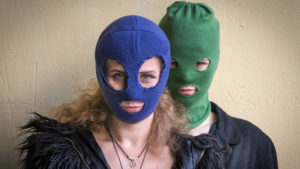
And then there was Pussy Riot: Riot Days. PUSSY RIOT! The Russian activists headlining the Auckland Fringe and flying the Save our Unique Landscape banner for Ihumātao. Rand T. Hazou reported:
One of the best lines in the performance comes after Masha narrates the group’s early protest in Revolution Square. Escaping the confused security guards the members of the group explained that they were ‘drama students’ – emphasising the seemingly innocuous aspects of theatre as an intellectual and immature pursuit. Yet as Riot Days demonstrates, theatre and performance can be powerful and inspiring, helping to galvanise people who share political commitments. In undergraduate theatre courses Political Agit-Prop, or agitational propaganda, is often described as a fairly dross unimaginative form of theatre that emerged in Soviet Russia in the mid 1930s. It is usually critiqued as a form of performance that is overly didactic and involves shouting political messages at an audience in the hope, they will join a cause. Pussy Riot: Riot Days is reinvigorated agit-prop, presenting a mode of performance that emboldens civic anger. As we deal with the rise in strong-man politics and the Trumps and Putins of this world, and as we steer a course through the impact of toxic masculinity in this country, perhaps more than ever we need forms of art that help us channel our anger and build a sense of political commitment and solidarity. The revolution might not be televised, but as Pussy Riot: Riot Days shows, it might be theatricalised
I managed to get to one night of Auckland Fringe especially for I am Rachel Chu. While I have a vested interest with creator Nathan Joe being a Theatre Scenes writer, it was personally one of my favourites of the year (despite, or maybe because of the fact that I was called in to be the bride in the reenactment of the film’s centrepiece wedding) . The production provoked Cynthia Lam to reevaluate her ambivalent thoughts on the hit film, and the show returned for a revamped second season at The Basement later in the year.
Proudly Asian Theatre produced the image-based piece Tide Waits for No Man: Episode Grace by Nikita Tu-Bryant for the Auckland Fringe, challenging white orientalist notions of Chinese femininity.
With Sam Brooks’ Actressexual, Auckland Fringe featured a bonafide controversy. The Spinoff Culture editor led a bolshy pre-show publicity campaign, claiming that NZ theatre was stuck in the 1980s with male playwrights writing substandard roles for women. In Actressexual Brooks would write a monologue for a different female actor each night, but The Pantograph Punch‘s Kate Prior argued that Brooks’ attempt at allyship was doing the exact opposite. Rachael Longshaw-Park followed with a response for Theatre Scenes, joined by practitioners Saraid de Silva Cameron, Chye-Ling Huang, Amanda Grace Leo, Renee Liang, Bianca Michelle and Elyssia Ra’nee Wilson-Heti. The group offered the following provocations for future allyship:
Get women involved
Never assume to talk for any marginalised group in your work or otherwise
Actively give or provide space as an Ally
Be constructive, not destructive
Never stop reflecting and interrogating your work
For anyone making theatre it is well worth reading their points in full. Rachael concluded: “The challenge is on all of us who are invested in New Zealand theatre: to interrogate ourselves, constantly. To Interrogate the work we make and the work that we see. To not be afraid to crack open what is in front of us.”
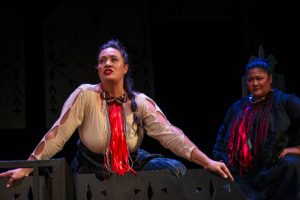
Finally, the Auckland Arts Festival delivered performing arts goers a number of local and international treats, including As it Stands, The Magic Flute, By Heart (in which ten strangers memorise a sonnet!), A Man of Good Hope, Ulster American, The Dreamer, and Grand Finale. It was very encouraging to see New Zealand’s Trick of the Light, regular travelers on the international festival circuit, playing at the Auckland Festival with The Bookbinder (which I first saw years before in Basement Theatre’s foyer!).
The ensemble version of Wild Dogs Under My Skirt by Tusiata Avia was the undoubted standout of the Festival, co-produced by Silo Theatre. Cassandra le la Croix offered her perspective:
Like the first bite of pisupo, your gut is left feeling heavy but your heart is fulfilled with delight as if letting go of that secret you’d been holding back from your mother for many years. The corned beef that sat there on a stool, taunting and tantalising the audience in the beginning reminded me so much of the multi layered and complex polynesian women standing before us on stage. Each wove their own experienced pain and recognised strength in every word they spoke, you couldn’t help but reply back with a shared knowledge and watering eyes.
FUNDED LEADERS
In reflecting on 2019, Auckland Theatre Company‘s Artistic Director told the NZ Herald that “I’ve been in this business long enough to know that there are good years and there are bad years.” He was pleased to report that 2019 had been a bumper year.
While this is good news for audience numbers (and indeed, career sustainability for the artists ATC hires), it doesn’t go unobserved that these results were off the back of some incredibly conservative programming at their home base Waterfront theatre (previously criticised for its gender stats).
At the start of the year Tom Scott’s ‘Ma & Da Season’ of Joan and The Daylight Atheist had Matt Baker asking “why these plays, why now?” Dishing out our best colonial silverware, The Audience by Peter Morgan tided audiences over while we waited for the next season of Netflix’s The Crown to drop. Reviewers Sharu Delilkan and Tim Booth were disappointed that John Guare’s 1990 play Six Degrees of Separation fizzled out rather than ending with a bang. Benjamin Henson’s helming of Tom Stoppard’s 1966 Rosencrantz and Guildenstern are Dead delivered “a highly polished and excruciatingly funny vision of the gaping abyss” according to Irene Corbett.
At Q Theatre, ATC produced Albert Belz’s Astroman with Te Rēhia Theatre for the Auckland Arts Festival, transporting audiences back to 80s NZ. The season was marred by homophobic and transphobic jokes in the script (called out on Twitter by Shane Bosher). Gabriel Faatau’uu-Satiu felt these “could have been reworked to avoid empowering ignorance, but what does it say about the audience that they managed to get the most laughs on opening night?”
Also at Q, ATC partnered with Prayas theatre for A Fine Balance, the stage version of Rohinton Mistry’s novel, which Prayas had first staged at TAPAC in 2015. I was in town for this and thrilled to see director Ahi Karunaharan’s vision realised in Q Rangatira, if lacking some of the community energy of the earlier production. Rand T. Hazou commented:
this co-production hopefully signals an exciting shift in the creative direction of the ATC as it partners with other creative voices of Auckland’s community to bring a wider range of stories to the stage and develop audiences so that the company can truly deserve the title of being Auckland’s flagship theatre company.
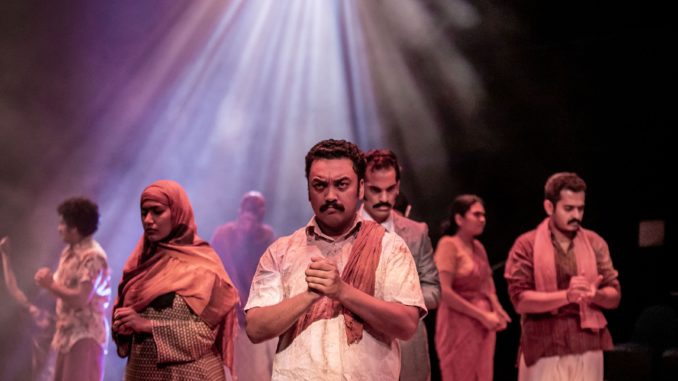
While different productions have different venue needs, ATC make a loud statement with what they choose (or not choose) to produce on their main Waterfront stage. An unfortunate distortion of their 2019 season was that their Waterfront programming centred Pākehā and colonial perspectives while Māori and Indian work played off-site at Q Theatre. As Auckland’s leading theatre company there will always be different agendas around what people need ATC to be. Personally, I am still waiting for to truly embrace its responsibility of being a theatre company for all of Tāmaki Makarau.
ATC continue to do good work with their youth orientated Here and Now Festival at the Waterfront Theatre. 8 Reasonable Demands by Joni Nelson, got stuck into hypocrisies in queer politics, demonstrating “that we are not as progressive as we might imagine ourselves to be in Auckland.” Musical The Gangster’s Paradise by Leki Jackson Bourke exemplified the fruitfulness that South Auckland has to offer. And Binge Culture’s Watch Party prompted Irene Corbett to produce this quality meme, which sums up ATC’s 2019 year aptly:

Silo Theatre had a mixed season, having continued to downside the number of new productions they produce each year. Following the Auckland Arts Festival co-production Wild Dogs Under My Skirt, Artistic Director Sophie Roberts directed Sarah DeLappe’s Pulitzer Prize nominated play The Wolves, focused on a soccer team of young women. As Rachael Longshaw-Park argued, this production presented quite the victory:
The Silo team has made some brave choices with their casting this season, with the core cast of women all under the age of twenty-two, most still at high school themselves, with the majority making their professional stage debuts. By investing in these young performers Silo demonstrates its commitment to developing our industry’s talents and welcoming the new generations (and storytellers) onto our stages.
The Blind Date Project, which Silo had last presented in 2014, was a baffling choice of production to bring back, although its guest actor format perhaps made it an economical choice for filling a programming hole. Audiences however complained of poor sightlines at the Q Loft turned bar. Irene Corbett wrote:
All the promotion for this show banks on a high level of hilarity so I was surprised to hear fewer and fewer laughs over the course of this date – perhaps it was a little too familiar to the audience? It is not often you can accuse a show of being too relevant. Date number one (opening night) was the blighted reflection of modern Tinder romance, strangers trying to negotiate a range of emotional needs and insecurities through a hookup.
With both Wild Dogs and Blind Date returning from previous seasons, and The Wolves being an established American play, Ahi Karunaharan’s Western/Bollywood Masala mash up My Heart Goes Thadak Thadak was the only substantial new offering in Silo’s 2019 season. While Karunaharan hadn’t managed to reconcile the audience’s interactive role as film set extras with a fulfilling dramatic engine to tell the story of a troubled film set, I loved the world created for the production and its subversive exploration of filmic myth-making, appropriation, and authenticity. Maulik Thakkar found the work to be “a powerful reminder that our communities are crying out to be heard, and that our stories are as resonant as those who came before and after us.”
Massive Company debuted Half of the Sky, renewing their semi-regular partnership with UK writer Lennie James. While the work was very slow to find its feet, by the end it delivered a moving story on sisterhood, love and loss.
Red Leap Theatre‘s stage adaptation of Janet Frame’s Owls Do Cry proved divisive. While Cynthia Lam found it “evocative and exciting”, I was deeply dramaturgically frustrated by the production. The novel doesn’t obviously lend itself to theatricalisation, and while Malia Johnston’s physical imagery managed to capture something of the feeling of reading the book, greater context at the outset would have helped earn the abstract places the production wanted to go.
Barbarian Productions brought Sing it to my Face to Auckland, forming volunteer choirs representing three distinct age groups to stage an inter-generational debate, set to music, around the present state of the world, how we got here, and where we want to go.

Nightsong debuted the highly praised absurdist hostage drama Mr Red Light, although this was somewhat overshadowed by the offstage drama around the company’s funding. Having reworked their company structure to become eligible for CNZ’s Toi Uru Kahikatea (the Arts Development Investment Programme, which gives ongoing funding to clients), Nightsong were subsequently dropped from the programme after less than a year. Ben Crowder and Carl Bland went public with their experiences, and called for support for the suite of projects they had been developing. As a platform for Ben and Carl’s philosophically insightful and visually effervescent productions, Nightsong have less of an obvious constituency or niche than other Kahikatea organisations. Nevertheless, after years of striving, Nightsong believed they had finally found a pathway to sustainable practice. With funding unexpectedly withdrawn, Ben and Carl, some of our most experienced theatre makers, found themselves once again in the position of scrambling to continue with their practice against uncertain financial prospects.
THE INDEPENDENT ECOLOGY
One of the thing’s about the $3.92 figure from The Basement is the amount of vital work happening in Tāmaki Makaurau’s independent theatre scene, despite low remuneration (just think what could be achieved under more sustainable conditions?) For anyone who really wants to take a pulse of Aotearoa now, you need to get out to the theatre.
The shows that Theatre Scenes has covered this years provides a snapshot of the passionate activity and wide interests of our theatre makers: Maniac on the Dance Floor by Natasha Lay explored the lived experience of bipolar, Embers Collective’s Read My Lips presented stories from Auckland’s deaf community, Eleanor Bishop and Karin McCracken advocated for a positive sexual consent culture in Yes Yes Yes, Amber Liberte explored the mega-structures of contempory Auckland in AKL, Babel. Kasiano Mita’s Talofa Papa and Alesha Ahdar’s My Kuia paid tribute to forebears, An Organ of Soft Tissue by Erin O’Flaherty continued the #MeToo conversation, and in First World Problems 2.0 a team of creatives spilled the chai on a range of South Asian experiences in Aotearoa.
At The Basement, Grace Bentley’s Woman of Citrus peeled back the layers on Aotearoa’s racial divide. Jess Macdonald observed:
It is clear Bentley’s marketing material – celebrating her powerful, black beauty – invited and enticed many people through the Basement doors for the first time. Post-show, audience members celebrated the move, and highlighted a desire to see much-needed and continued expansion to the Basement’s line-up – to become a space which not only lifts up the voices of LGBTQI creators, but ethnic minority groups long marginalised and lacking a platform to call their own.
Proudly Asian Theatre debuted PINAY by Marianne Infante, the first multilingual Filipino-Kiwi play, a response to the confronting lack of Filipino representation in Aotearoa media. Rachael Longshaw-Park wrote:
Sitting in the Basement Theatre I felt a part of something bigger than just this play, or this story, because in that moment we all took part in a new chapter of our theatre history. In the fight to have inclusive stories heard I encourage you to get yourself along to this play, and even if you can’t feel the gravity of this milestone, then you’ll still be welcomed in and wrapped in the same warmth, acceptance, and celebration that I was on opening night.
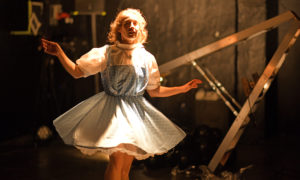
The Basement trialed a new Basement Visions programme to support the sustainable practice of established artists and offer longer seasons. The first was Working on My Night Moves, the final show in a trilogy of works from Julia Croft (collaborating Nisha Madhan with Meg Rollandi for Night Moves) which imagines feminist futures. Having removed the seats from The Basement, the audience negotiated the space with Julia as she set up for a series of moments throughout the piece. Jess Macdonald wrote:
The audience are constantly lulled from a state of relaxation into one in which we watch Croft battle against the patriarchal status quo. As with each wave of the feminist movement, another challenge soon follows each triumph. More space needs to be manipulated, pushed against and distorted; Croft’s resulting representation is both visceral and captivating.
I had to go all the way to Edinburgh to catch Working on My Night Moves, and found it really exciting to see an artist so fearlessly moving forward into new formal territories with their work. I surveyed audiences in Edinburgh who went to see it, and while there were some divided responses, what is striking about the work is the interpretative space it opens for audience, inviting a range of reflections and resonances. The show was embraced by Edinburgh, recognised by the Total Theatre award for Physical and Visual theatre (a massive coup!). Julia Croft and collaborators are trailblazing really special work, and I can’t wait to see where they go next.
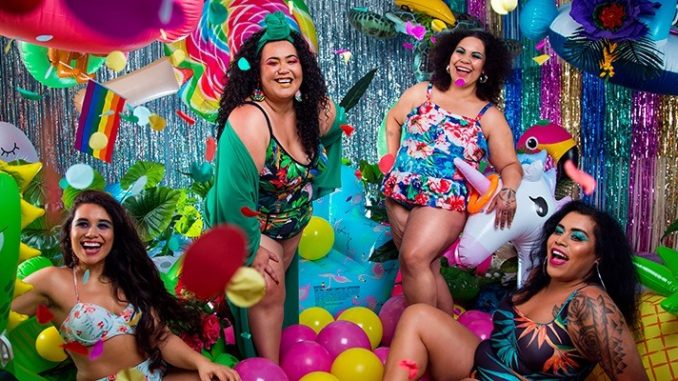
FAFSWAG were also supported through Basement Visions, debuting Reclamation. Cassandra De La Croix found its celebration of femme to be raunchy, revolutionary, and “so Riri savage fenty”:
These taahine rebuke every word that has been used against women who do not fit in the western ideals and with their varying shapes and skin on stage they uplift all things being brown wāhine. It is time to decolonise the mind, tongue and the body and ceremonialize the power that we have for all future women.
MUSICAL BARRICADES
Who needs Disney Plus or Will Smith in Genie pants when you can visit Agrabah for yourself at The Civic? Disney’s Aladdin the Musical was the first of a number of big musicals to play in Auckland this year (was there ever a more perfect culturally ambiguous musical to match The Civic’s faux-orientalist interior?). Madiba the Musical, a celebration of Nelson Mandela’s life, played at the Bruce Mason Centre. Sharu Delilkan rocked out with School of Rock the Musical (created by true anti-establishment icons, Julian Fellowes and Andrew Lloyd Webber), a “joyous inter-generational treat.”
Green Day’s American Idiot: The Musical inexplicably featured an all-white touring cast, fatally undermining its exploration of inequality and protest. Irene Corbett considered its relevance in an Aotearoa context:
The spirit of dissatisfaction, and themes of government betrayal, suburban death, economic crisis ring true. That being said, while students protest the University of Auckland’s handling of white supremacist material on campus and rangitahi occupy Ihumātao, it is clear that in a New Zealand context true protest and revolutionary spirit is not with our mohawked youth (our punk scene is impotent at best), but with young Māori, Pasifika, and people from other minority groups. This musical would have greater resonance if there was some commentary on race or class.
Perhaps even more disappointingly, the casting for Amici and Auckland Music Theatre’s lavish Les Miserables was also overwhelmingly white presenting. I think its quite appropriate for Auckland Music Theatre to have presented Les Mis at The Civic to celebrate the 100th anniversary of the community organisation, however, this was not the story that they led with: everything was coded to try to convince audiences they were going to a professional production of the beloved show. Amateur theatre deserves celebration, but dressing it up to look professional (and charging high ticket prices) does both amateurs and professionals a disservice, creating further distortions in an ecology which the CNZ/NZ on Air research emphasises there are limited opportunities for trained professionals to sustain a career.
MEANWHILE IN PŌNEKE
The NZ Fringe in March presented me with an opportunity to really get immersed in Wellington theatre. I wondered:
Can you take the pulse of a city through the shows performed on its Fringe?
Can you judge the heart of a Festival by the visitors who have come to play?
Can you take stock of the world via the canary call of the artists who have something to say?
I wrote a full response to the NZ Fringe, including how shows sat differently on and after the March 15th terror attack in Ōtautahi.
I reflected on my first months in Wellington for the Playmarket Annual 2019, highlighting the Kia Mau Festival as:
the most essential event in Wellington’s annual theatre calendar – an outstanding programme curated by Hone Kouka. Here was work with verve, purpose and social awareness: Mitch Tawhi Thomas’s dark rom-com Pakaru finally shook us out of tepid theatre-going complacency.
The Dominion Post profiled how Wellington facing its own theatrical sustainability challenges; while “creatives are fighting to stay here,” there has been a pronounced “creative brain drain” over the past decade. With a venue squeeze, there is “no room to move in the cultural capital”; artists including Stella Reid and George Fowler have advocated for the need for a new versatile mid-tier venue seating 250-300. In the Playmarket Annual I commented on how Second Unit, a new initiative from the NZ Festival, was a boon for the employment of Wellington actors (and provided upskilling in immersive/interactive performance!).
Nathan Joe took up an unofficial critics-in-residence to review Shane Bosher’s Wellington theatre season of Cock by Mike Bartlett. The season had Joe reflecting on the shifting relevance of the text:
There’s a fascinating conversation to be had around plays that are not quite old and no longer new, not quite speaking to the right now but not quite timeless yet either. Cock feels somewhat stuck in this limbo, due to its somewhat dated interrogation of sexual politics, but is no less impressive as a piece of writing. The way the play has shifted for me the most is that its conversations around gender, sexuality and assumed monogamy feel half-baked and somewhat reductive in 2019; the characters still trapped in conversations from when the play first premiered a decade ago, a stark contrast to the queer discourse available to us now.
2019 STAB Commission ransom. directed by Stella Reid and Neenah Dekkers-Reihana took over the entirety of BATS, which we were led around in groups of three. Premised on the abduction of an alt-right New Zealand politician, the politics of the work felt very present within my audience trio.
Finally, I contributed three moments in Pōneke theatre for The Pantograph Punch.
MEANWHILE IN ŌTAUTAHI
This year playwright and critic Nathan Joe returned to Christchurch, and I’m honoured to feature his end of year reflections on the city’s theatrical terrain:
Homecoming has been a recurrent theme of Christchurch’s theatre scene throughout this year. Something I’ve paid particular notice to, in no small part, to it being my own hometown that I’ve returned to. An unsurprising resonance. Art has a tendency to make us see patterns in everything.
Returning to Christchurch (from Auckland), then, has been an act of investigating how the city has changed since I left at the end of 2010. In many ways 2019 was the perfect year to return, the city on the brink of a new era. I don’t think I would be stepping completely out of line to call the state of theatre in Christchurch over the last few years as something of a cultural limbo, with little to no infrastructure for independent artists.
While Auckland has become a city where independent theatremakers go to experiment and find and develop their voices, Christchurch can claim to be the city that has bred many of those bold makers, including, but not limited, to the likes Chris Parker, Eli Matthewson, Hamish Parkinson, George Fenn, Alice Canton, Malia Johnston and Victor Rodger. I name these few in particular because they’ve, in various different ways, contributed to the reemergence of Christchurch’s arts this year. They too have had homecomings of sorts. It speaks to the evolving conversations we’re having as theatremakers on a national level, breaking free of our city silos, which is as exciting as any of the actual work being produced.
The most landmark moment of the year was undoubtedly Christchurch’s new fringe theatre venue Little Andromeda finding a semi-permanent space. An essential addition to the city’s landscape, addressing a blindspot that has plagued the infrastructure since forever. Despite being a city with the country’s oldest professional theatre company and leading performing arts schools, why has it taken so long? (Kate Prior’s article on The Pantograph Punch covering Little Andromeda’s homeric journey and evolution is essential reading.)
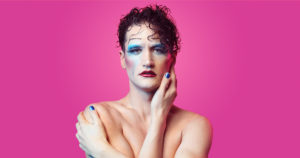
While I haven’t been able to catch all of the Court Theatre’s productions this year, all the mainstage productions have been of undeniably high calibre. Hedwig and the Angry Inch was a particular treat. I noted it was “the perfect musical for The Court and a city still figuring out its shifting identity. It is, after all, an ode to difference and change.”
Similarly ramping up the spectacle, but on the more family-friendly end, was the end of year production of The Wind in the Willows. With artistic director of the Court, Ross Gumbley, stepping down, it also serves as a swan song for his tenure. As new critic Charlotte Filipov remarked, the show was far from minimalist,“Gumbley’s plentiful, lush rendition… is sure to inspire, leaving little left to the imagination with its ample production.” In between, the Court revived Pacific Underground’s seminal Fresh off the Boat, “a highly entertaining evening that pays homage to giants of New Zealand theatre while also showcasing the best and brightest contemporary talent.”
With Christchurch Arts Festival, I was able to catch two theatre shows: Meremere was a display of buravaru movement and choreography, with a narrative journey that made me more than a little teary. Rodney Bell was nothing short of awe-inspiring under the direction of Malia Johnston. A showcase not only of the marvels of the human body and a refusal of its apparent limitations, but also a demonstration of the human spirit. I could feel the work shift something inside me.
The History of Different Light, an exploration of the company’s work with intellectually disabled performers was an unexpected gem. Innovative in its telling of a theatre company’s rich history, shaking off the rigid expectations of verbatim theatre. A simple but effective documentary theatre piece using AV to guide us through the archives with humor and sensitivity, while resisting any ounce of pity for its subjects.
Alongside the programming of Wild Dogs Under My Skirt and the array of local musical talent, I stand by my earlier words this year: “it’s a programme that seems directly plugged into the pulse and beating heart of what is happening right here, right now, in the city. Even if most people don’t know it.”
And most recently was Tiny Fest, a 14 hour performing arts marathon, where I attempted to cover as much as I could in my brief write up.
For a city that may have the perception of being a bit of a cultural wasteland, four organisations, of very different size and resources, facilitating some pretty fantastic work isn’t too shabby.
It’s fitting that in Cat Ruka’s keynote speech, she argued against the false ideal of innovation and, instead, “asked necessary questions on how we return the healing power to something that has been turned into a product. Reframing the question of who your audience is to who your audience should be.”
So what does the future hold for Ōtautahi? I am hopeful that Little Andromeda will continue its course, and I hope that artists all over take the opportunity to share their works in the space. It’s apt that the year closes with a production of what was once a Basement Christmas Show (The Opening Night Before Christmas), co-written by our very own Chris Parker. I look forward to the synergies and potential cross-pollination between cities developing even further.
There is a question that looms over Christchurch’s optimistic creative community though. That is also the question of sustainability. As much as I want for there to be more arts, I wouldn’t wish the burdens of being a broke theatremaker on anyone. Like solving one problem only to create another, It is both exciting and terrifying to think that Little Andromeda and Christchurch is going to go through many of the growing pains of Auckland and Wellington when Basement and BATS first began operating. If and – perhaps more optimistically – when Christchurch is a bustling theatre city, what will become of its theatremakers? How can Christchurch avoid the same mistakes or pitfalls other cities have already suffered or made? How can we guarantee this hard won work will be more than simply a flash in a pan? If there was ever a time for a nation-wide conversation in theatre, the beginning of a new decade seems as good a time as any.
Afterthoughts, or queer agendas.
Following some local controversy with the city’s only gay bar, which can only be described as courting transmisogyny for the lolz, it becomes far more urgent and pressing for theatre to hold a safe and welcoming space for the marginalized.
And you know what? Theatre in Ōtautahi is proving to reflect some of these needs.
Following Hedwig, The Court Theatre’s 2020 season promises two vastly different queer works which stick out like sore thumbs in the programme: Rent and Hir. Each one very much works of their time, reflecting their particular queer zeitgeist, for better or worse.
On the independent end, the inimitable Ray Shipley’s solo comedy show All This Crying Is Making Me Hungry was one of my personal highlights. A modest masterpiece of queer storytelling. Its return season I managed to catch thanks to Little A.
Two Productions (helmed by Tom Eason and Holly Chappell) continues to develop new voices with their yearly mentorship programme, which ended with a showcase of some hot emerging talent. That three of them (AJ Juer, Tim Maguire, Daniel Shute) happened to be queer and creating distinctively queer work was just icing on the cake, whether it was through clowning or in drag.
On the other hand, it’s the lack of cultural diversity that seems more glaring. The two major Pasifika works (Fresh off the Boat and Wild Dogs Under My Skirt) felt like much needed springs amidst a desert, but do little to rectify Christchurch’s colonial reputation. There is still much work to be done. – Nathan Joe
EVEN MORE FROM THEATRE SCENES IN 2019:
- Cirque du Soliel put up the big top again for Kooza
- Brigitte Knight filed brilliant pieces on Royal New Zealand Ballet’s Choreographic Series, Black Swan, White Swan, Bold Moves, and Hansel & Gretel, Complexions Contemporary Ballet Bach to Bowie and was left nonplussed by the World of WearableArt Award Show.
- Eli Matthewson and Brynley Stent shared the ins and outs of their former romantic relationship in Exes, a show Tim George compared to a “a chocolate tofu biscuit – from the outside it may look lumpy and strange, but it is considerably more substantial than first impressions may suggest.”
- Sau E Siva Creatives’s Rosalina returned to Māngere Arts Centre for its second sold out season.
- Michael Hurst brought the Troy story “earth-shatteringly into contact with the present” in The Illiad.
- Joey the War Horse FINALLY made its way to Auckland (the National Theatre production originally being announced for 2012).
- Sarah Foster-Sproull’s incredible ORCHIDS played Auckland and Wellington, where it was reviewed by Cynthia Lam and Brigitte Knight.
- Indian Ink presented a return season of Mrs Krishnan’s Party (third Auckland season in three years!) as part of a national (and international tour).
- Plumb Productions staged Lucy Kirkwood’s The Children, exploring generational responsibilities regarding the climate crisis.
- I Didn’t Invite You Here to Lecture Me by Amy Mansfield gave audiences “an education no student loan can buy you.”
- Phoebe Hurst was a Worm. It was demented and delightful.
- HeadSand from Benjamin Henson burrowed “deep into the audience’s mind, planting eggs which hatch both during and long after the production.”
- Fiona Collins returned after a decade teaching at the National University of Samoa with AloFA.
- Murray Edmond contributed a guest piece on three student productions in Auckland (Animal, Peer Gynt and Te Pakkhai, while Actors Program presented Welcome to Thebes as their grad show.
- Basement Theatre’s annual Christmas show welcomingly mostly ignored Christmas with A Frickin Dangerous Space-Mas, written by the team from Frickin Dangerous Bro, treating audiences with zany adventures at the International Space Station.
- Rounding out the year, Dust Palace challenged conceptions of womanhood with The WonderWombs.
FINALLY, FROM THE EDITOR:
I had to double count to check this was right, but this is the TENTH ‘Year in Review’ I have written for Theatre Scenes (I link to all of them at the end). At Theatre Scenes we hope to be able to continue to move towards a more national focus in 2020. My thanks to all the writers who have generously contributed this year: Brigitte Knight, Cassandra de la Croix, Charlotte Filipov, Cynthia Lam, Gabriel Faatau’uu-Satiu, Irene Corbett, Jess Macdonald, Matt Baker (now writing at Up your Arts), Maulik Thakkar, Nathan Joe, Rachael Longshaw-Park, Rand T. Hazou, Sharu Delilkan, Tim Booth, Tim George and Murray Edmond. For my talk of sustainability in this year’s wrap-up, I again need to acknowledge that Theatre Scenes itself does not represent sustainable critical practice, but with the help of some philanthropy we have been able to offer a small koha to reviewers for part of this year.
It is my strong contention that thoughtful criticism is essential for a healthy theatre ecology. If you would like to support us into the next decade or write for us, contact james@theatrescenes.co.nz
What will Aotearoa theatre be like in the 2020s? We are eager to find out!
– James.
SEE ALSO:
– The Pantograph Punch: Ten Moments in Aotearoa Theatre 2019
– RNZ Standing Room Only Performing Arts highlights 2019
Theatre Scenes Theatrical Year in Reviews: 2018; 2017; 2016 ; 2015 ; 2014 ; 2013 ; 2012 ; 2011 ; 2010

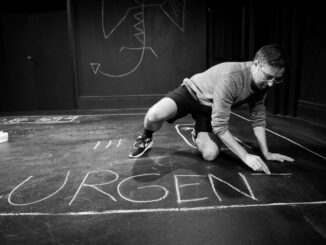
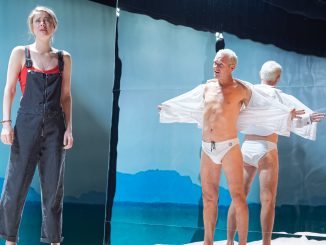
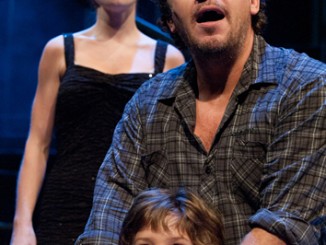
Leave a Reply